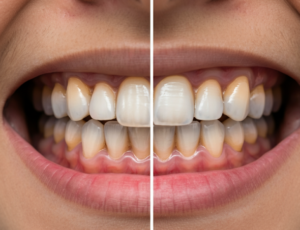Dental veneers have revolutionized cosmetic dentistry, offering individuals the chance to achieve flawless, natural-looking smiles. If you’re researching “dental veneers before and after,” this guide will provide all the information you need to determine whether they’re the right choice for you.
From understanding what veneers are to the dramatic transformations they can create, let’s deep dive into this highly sought-after cosmetic dentistry solution.
What Are Dental Veneers?
Dental veneers are thin, custom-made shells typically crafted from porcelain or composite resin. These shells are designed to cover the front surface of teeth, effectively concealing imperfections such as stains, chips, gaps, or uneven alignment. Veneers closely mimic the look and feel of natural teeth, making them a popular choice for smile makeovers.
Common Reasons for Getting Veneers
People choose veneers for a variety of reasons, including:
- Whitening teeth that are discolored or resistant to bleaching.
- Fixing chipped or cracked teeth.
- Closing gaps between teeth.
- Correcting minor misalignment or uneven teeth.
The Veneer Process Explained
Getting veneers is a multi-step process, but the results are worth the effort. Here’s what you can expect:
1. Consultation and Planning
The first step is a consultation with your dentist to discuss your goals. They’ll evaluate your teeth, take X-rays, and create a personalized treatment plan. Here’s where you’ll decide the number of veneers and choose their color and shape.
2. Preparation
During the preparation phase, your dentist will remove a thin layer of enamel (usually less than a millimeter) from the teeth receiving veneers. This makes room for the veneer shells to fit seamlessly. Don’t worry; it’s a minimal amount and ensures the veneers look natural.
3. Impressions
Once the teeth are prepped, your dentist will take impressions or digital scans of your teeth. These are sent to a dental lab, where your custom veneers are crafted to match your smile.
4. Placement
At the final appointment, your veneers are bonded to your teeth using a strong adhesive. Your dentist will adjust them as needed to ensure a perfect fit and natural appearance.
Why Dental Veneers?
The most exciting aspect of veneers is the dramatic difference in before and after results. Here are some examples of common transformations:
- Discolored Teeth: Patients with deeply stained teeth often see a bright, even smile after veneers. Unlike whitening treatments, veneers provide a permanent solution for discoloration.
- Chipped or Worn Teeth: Veneers restore the shape and length of worn-down teeth, creating a youthful and symmetrical appearance.
- Gaps and Misalignment: Whether it’s a small gap or slightly crooked teeth, veneers can create a straight, uniform smile without the need for braces.
Many dental practices showcase real-life results on their websites or social media pages, so you can browse photos of patients who’ve undergone a veneer makeover.
Benefits of Dental Veneers
Dental veneers offer several advantages that make them a coveted cosmetic treatment:
- Natural Appearance: Veneers blend seamlessly with your natural teeth, offering a realistic result.
- Quick Transformation: Unlike braces or aligners, veneers deliver near-instant results, typically in two visits.
- Durable and Long-Lasting: High-quality porcelain veneers can last 10–15 years with proper care.
- Customizable: You can work with your dentist to design the perfect shape, shade, and size for your face.
Potential Drawbacks to Consider
While veneers offer incredible benefits, it’s important to weigh potential drawbacks:
- Cost: Veneers are an investment, with costs ranging from $800 to $2,500 per tooth.
- Irreversible: Since enamel is shaved down, the procedure cannot be undone.
- Maintenance: You’ll need to practice excellent oral hygiene and avoid habits like biting hard objects (e.g., fingernails, ice) to protect your veneers.
Cost of Dental Veneers
The price of dental veneers depends on several factors, including the materials used, the expertise of the dentist, and the geographic location. Here’s a general breakdown:
- Composite Veneers are more affordable, costing $800–$1,500 per tooth, but they have a shorter lifespan.
- Porcelain Veneers are pricier, at $1,500–$2,500 per tooth, but they’re more durable and stain-resistant.
Most dental insurance plans don’t cover veneers since they’re considered cosmetic. However, many dental practices offer payment plans to make the procedure more accessible.
How to Maintain Your Veneers
To keep your veneers looking their best, follow these tips:
- Brush and floss regularly to maintain gum health.
- Avoid biting hard foods or objects that could chip the veneers.
- Wear a nightguard if you grind or clench your teeth.
- Visit your dentist regularly for check-ups and cleanings.
With proper care, veneers can stay stunning for a decade or more!
Choosing the Right Dentist for Veneers
Selecting the right professional for your veneer treatment is crucial. Here are some tips:
- Experience and Expertise: Look for a cosmetic dentist with a portfolio of veneer transformations. Certifications or advanced training in cosmetic dentistry are also a plus.
- Patient Reviews: Read reviews and testimonials to gauge the dentist’s reputation.
- Technology Used: Practices that use advanced imaging and digital smile design can ensure more precise results.
- Communication: Your dentist should listen to your goals and make you feel confident about the procedure.
Is It Time to Discuss Dental Veneers?
Dental veneers offer remarkable “before and after” results, helping you achieve the perfect, confident smile you’ve always wanted. Whether it’s correcting discoloration, repairing chips, or creating symmetry, veneers cater to a wide range of aesthetic needs.
If you’re ready to take the next step, schedule a consultation with an experienced cosmetic dentist. They’ll evaluate your needs and create a personalized treatment plan designed to transform your smile. Veneers aren’t just about looking good—they’re about feeling amazing, too!
Take the first step toward your dream smile and experience how veneers can enhance your life.
_______________________________________________
FAQs about Dental Veneers
1. How long do dental veneers typically last?
With proper care, porcelain veneers can last 10–15 years, while composite veneers may last around 5–7 years. Regular dental check-ups, good oral hygiene, and avoiding habits like teeth grinding or biting hard objects can help extend their lifespan.
2. What should I look for in a dentist for veneers?
Choose a cosmetic dentist with experience and a strong portfolio of veneer transformations. Look for reviews, certifications, and use of modern technology like digital smile design to ensure precise and natural-looking results. Clear communication and understanding of your goals are also key.






